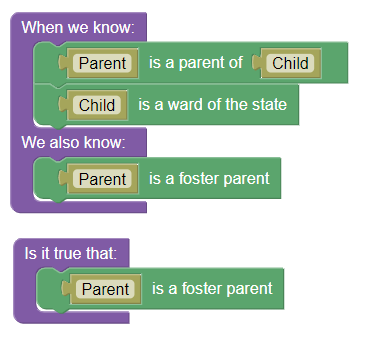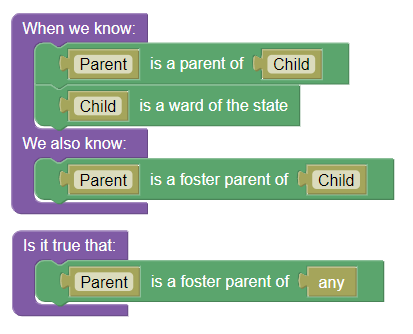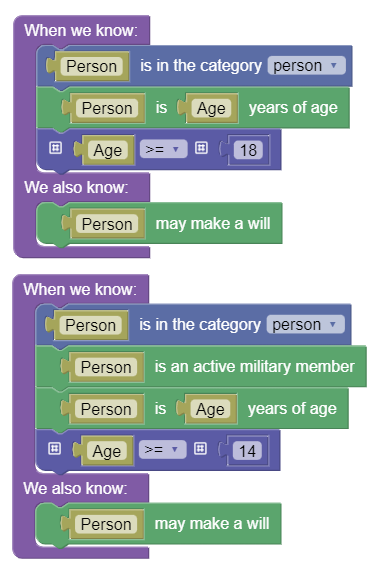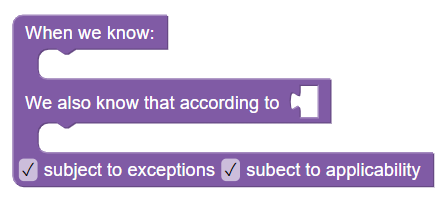Rules
Rules are the most important part of encoding in Blawx. They are where you describe the inferences Blawx can make to generate legal conclusions.
A rule has two parts. The first part is the “conditions” that must be met for before the inference is valid. The second part is a statement that can be inferred to be true, in those conditions, called the “conclusion.”
Blawx offers two different kinds of rules: basic rules, and attributed rules. A basic rule looks like this:

A basic rule block has one connector for the conditions, and another connector for the conclusion. A rule block needs both connections filled to work properly. A rule can only have one conclusion.
A Note on If/Then
If you are a programmer, or if you have experience with other procedural approaches to formalization, like production rule systems, you might expect that a rule represents an "if/then" relationship. That the semantic meaning of the rule is "check to see if these conditions are true, and if so, do these conclusions".
Blawx intentionally does not use the words "if/then" to describe rules, because that's not what a rule says. What a rule says is "whenever the conditions are true in a situation, the conclusion is also true inside that situation."
The biggest difference between the two meanings is that a rule in Blawx works in two directions. If a conclusion is not true inside a model (perhaps because you provided that information as a fact), Blawx can infer that the conditions are not all true, also.
When using Blawx, remember that you are not describing what steps the computer should follow. You are describing what can be inferred (the conclusion), and when it can be inferred (when the conditions are true).
Writing Reversible Rules
Blawx will take the rules that you provide, and in the background generate a new set of rules for proving the opposite conclusion, so that your encoding will be capable of answering additional questions (like "why not?") without you needing to write more rules.
However, the method that Blawx uses to do this requires careful design of your rules. To get the best possible use of rules in Blawx, you should design them with this in mind:
Only include a condition if:
- the condition is necessary for the conclusion to be true, and
- the opposite of that condition is sufficient by itself for the conclusion to be false, assuming that the preceding conditions are true.
This problem is easier to understand with an example:
Consider a rule that says a person is a foster parent if they have a child, and if that child is a ward of the state. Using that rule, you might ask whether someone is a foster parent, like this:

We know that both conditions are necessary for the conclusion to be true.
The question is whether they are sufficient to disprove the conclusion when negated, and the preceding conditions are true.
For the first condition, there are no preceding conditions, so we just need to ask whether when the person does not have a child, they a not foster parent? Yes. That follows. So the first condition reverses nicely.
For the second condition, we presume the first condition is true. The person has a child. If we reverse the second condition, and say that the child is not a ward of the state, does that imply that the person is not a foster parent? No. They might be a foster parent who also has biological children. So that condition does not reverse properly.
There are usually multiple ways of resolving this sort of problem. Here, we might choose to conclude rather whether the person is a foster parent to that particular child. Then, in our code, instead of asking whether they are a foster parent generally, we can explicitly ask whether they are a foster parent to anyone. Here is what the code that reverses properly would look like.

If the person has a child, and that child is not a ward of the state, it is reasonable to conclude that the person is not a foster parent to that child. So the negation works properly. And instead of having an attribute that describes being a foster parent, we can ask whether the person has a foster parent relationship to anyone else.
Dealing with Options
Blawx does not yet have an "or" block, to allow you to set out more than one way that a conclusion might be inferred in your code. In order to represent multiple possible routes for your conclusion to be inferred, you must create multiple rules, one for each possibility.
Consider the rule "a person must be 18 years of age or in active military service to be able to make a will". That would be implemented like this:

Note that when these possibilities are reversed, each is reversed independently. So the conditions for each must be reversible alone, without the conditions in the other alternatives, for negations to work properly.
Attributed Rules
As an easy way to include information about where your rule arises from in the legal text, Blawx offers you the ability to create "attributed" rules, which look like this:

The attributed rule is pre-loaded with the reference to the current section of the legal text you are encoding, which makes the text of that section available in your explanations. It also allows you to quickly set out that the rule is subject to being overridden by other sections, or that the rule may not apply to particular objects. For more information on these features, see the defaults, exceptions and applicability section of the documentation.